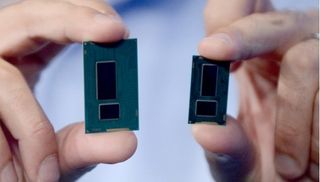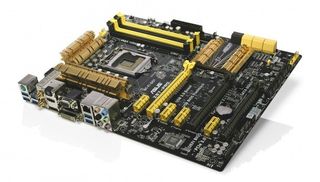Intel reveal new Broadwell CPU technology, due out next year

The successor to Intel's Haswell CPU technology, "Broadwell", has been revealed and shown working here at the Intel Developer Forum in San Francisco. The chip is built using a whole new production process that shrinks Haswell's 22nm transistors down to 14nm. That is tiny.
As you can see from the side-by-side comparison between the low-power Haswell and Broadwell systems-on-a-chip (SoC) in the picture above, there's a big difference in actual size, and because Intel are using their very latest production methods on this new CPU it also should be a good deal less power-hungry than it's older brother.
They showed a development platform running working Broadwell silicon right next to a Haswell machine, both using CPU intensive benchmark Cinebench. The Haswell chip ran at an impressively low 6.8W under load, but Broadwell managed just 4.9W. Intel are saying that's without even doing much power optimisation on this new processor either, which ought to mean even greater power reductions once they've finalised the platform. They don't have long to do that though as new Intel CEO, Brian Krzanich, has Broadwell shipping to their partners in just a few short months.
“This is it, folks,” he said. “14nm is absolutely a reality, it's absolutely coming to a PC near you and we'll see it in product next year.”
The only downside with Broadwell right now is that it's unlikely to be compatible with any of the 8-series motherboards out there in the market at the moment. That's a shame as usually the die shrink of a process is at least partially compatible with the previous generation's motherboards. With the move from Sandy Bridge to Ivy Bridge CPUs the new chip would at least run in the older boards, even if it didn't have full access to the entire feature-set.

The reason for this incompatibility is unclear. Intel wouldn't be drawn on the subject, but rumours from some motherboard manufacturers are that the integrated voltage regulator (iVR) is being moved off-die and back onto the motherboard. Some people have claimed that the extra heat generated by shifting the iVR onto the CPU has been responsible for the weaker overclocking performance of Haswell versus Ivy Bridge.
I spoke with Dan Ragland, a Senior System Engineer at Intel, about this exact thing. “We started off without the integrated VR, then we did the integrated VR. What we do in the future I can't really comment on,” he said, cagily. “But we always mix things up, so I wouldn't rule it out.”
The biggest gaming news, reviews and hardware deals
Keep up to date with the most important stories and the best deals, as picked by the PC Gamer team.
It's not a flat denial, unfortunately nor is it a confirmation. As to whether the iVR is actually affecting Haswell overclocking though, he was more forthcoming.
“That is really debatable,” he said. “Even internally we asked ourselves are we crippling ourselves by doing this? It has a number of other benefits, in addition to the cons you're already well aware of. So in the end it's kind of moot, especially if you've got a liquid cooled system. You could really argue in an air-cooled environment, maybe. But there are other process and architecture things that might be coming into play.”
So if you've got proper cooling for your overclock the iVR shouldn't be a problem. Though that would also indicate that if it was removed there may be a reduction in heat production on-die. But we shouldn't have to wait too long now with Broadwell parts tipping up hopefully early in the new year.

Dave has been gaming since the days of Zaxxon and Lady Bug on the Colecovision, and code books for the Commodore Vic 20 (Death Race 2000!). He built his first gaming PC at the tender age of 16, and finally finished bug-fixing the Cyrix-based system around a year later. When he dropped it out of the window. He first started writing for Official PlayStation Magazine and Xbox World many decades ago, then moved onto PC Format full-time, then PC Gamer, TechRadar, and T3 among others. Now he's back, writing about the nightmarish graphics card market, CPUs with more cores than sense, gaming laptops hotter than the sun, and SSDs more capacious than a Cybertruck.
Most Popular

